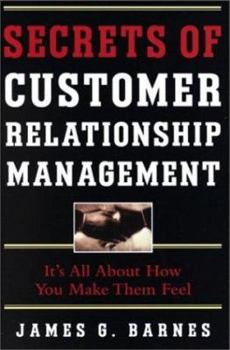Secrets of Customer Relationship Management: It's All about How You Make Them Feel
Relationship marketing has been a buzzword for years, but is it anything more than that? Who really knows what it means? This work aims to provide readers with a complete overview to understanding the... This description may be from another edition of this product.
Format:Hardcover
Language:English
ISBN:0071362533
ISBN13:9780071362535
Release Date:September 2000
Publisher:McGraw-Hill Companies
Length:316 Pages
Weight:1.55 lbs.
Dimensions:1.1" x 6.3" x 9.2"
Customer Reviews
5 ratings
Traditional business values.
Published by Thriftbooks.com User , 17 years ago
When executives hear the term "customer relationship management" (CRM), they often break out in a cold sweat amid visions of six- or seven-figure implementations of staggeringly complex systems. But have no fear, you won't stumble over such looming obstacles in James G. Barnes's book. Rather he chooses an old-fashioned approach to CRM: actually building relationships with your customers. Barnes provides a variety of techniques to accomplish this basic task. Some of his suggestions are fresh and inspired, while others will sound pretty familiar to anyone in business. Either way, he documents them with his own thorough research and insightful accounts from other writers. Some readers will miss the nuts-and-bolts technical analysis that has come to define the modern concept of CRM, but getAbstract recommends this book to executives, marketing professionals and customer service managers who want to get back to traditional business values.
The subtitle should be the title
Published by Thriftbooks.com User , 23 years ago
It IS all about how you make them feelTo the company or individual who believes that price and product features are dominant drivers of customer behavior, Barnes doesn't so much reveal secrets, as issue a direct challenge arguing that the health of the customer relationship determines the long term outlook of the business. Barnes' view, based on a considerable amount of research with companies in North America and Europe, is that even customer satisfaction and customer loyalty are not sufficient concepts for understanding why customers chose to do business with a particular firm. In his view, it's emotional. Customers have so many choices today, and there are so many good suppliers, that they can, (in fact need to), base their purchase decisions on how they feel about doing business with a given supplier.Just because it's about emotions, however, doesn't mean it's unmanageable or even unmeasurable. For his clients, Barnes assesses the value that can be created for the customer in the relationship. He tests the company's actual performance in delivering it. He assesses, as well, the long term economic value of the relationship to the company and the cost of maintaining it. With this information strategic decisions can be made about where and how much to invest in developing relationships.Like many business books today, this book could stand a resolute editor. Barnes is clearly pitching a point of view, so perhaps it's understandable that he covers the same ground from several different directions, but it does get repetitive. The repetition, however, doesn't diminish the message, and the reader looking for justification for developing about the emotional connection to the customer will find a great deal of support, insight, and methodology here.
Finally!
Published by Thriftbooks.com User , 24 years ago
At last, someone who understands that "loyalty" is an emotional bond, human feeling, not simply bribery or monopolization under a sweeter-sounding name. Barnes' background in psychology allows him to take this view, and as a result he can write more usefully about what loyalty really is and really isn't than most anyone else out there.
CRM is personal.
Published by Thriftbooks.com User , 24 years ago
Barnes's discussion on CRM is unique: instead of looking at managing systems and processes--what I called the operation issues of CRM--Barnes discussed and illustrated how personal CRM should be. This is not a manual for CRM implementation; if you do happen to work on CRM related matters, this is a must as you will gain an insight of what CRM is about--making your customer feel good. It's that un-complicated!One chapter I found irresistable is the chapter on Internet and CRM. I believe the author had summarized and highlighted the essence of implementing CRM through Internet, and what considerations to give etc.. It is not tactical, but you will find his inputs valuable.Happy reading.
An important reminder about loyalty!
Published by Thriftbooks.com User , 24 years ago
Barnes argues that "genuine" customer relationships are built by understanding and attending to the emotional experience generated by customer interactions. Accordingly, retention tactics that merely increase switching costs or reward customers for loyal behaviour are not sufficient in creating true long-term customer value.Barnes' work accepts and compliments the work of other authors who present a more mechanical, economic view of the customer relationship. He reminds those with technology-driven customer strategies that CRM is fundamentally about people. Readers using this book in addition to Rust, Zeithaml and Lemon's "Driving Customer Equity" will gain a very balanced appreciation of customer-focused marketing today.Long on text and short on graphics and case examples, this book is not a quick read. However, for those compelled to invest some time in this subject, the content is well written and useful. Chapter 4 contains a particularly useful discussion on drivers of customer value. In Chapter 10, Barnes presents a relatively pessimistic view on possibilities of developing genuine customer relationships through the Internet. Accordingly, those looking to improve their e-channel knowledge should probably look elsewhere.Dan Michaluk is a simulation designer for ExperiencePoint, creators of award-winning business simulations.






